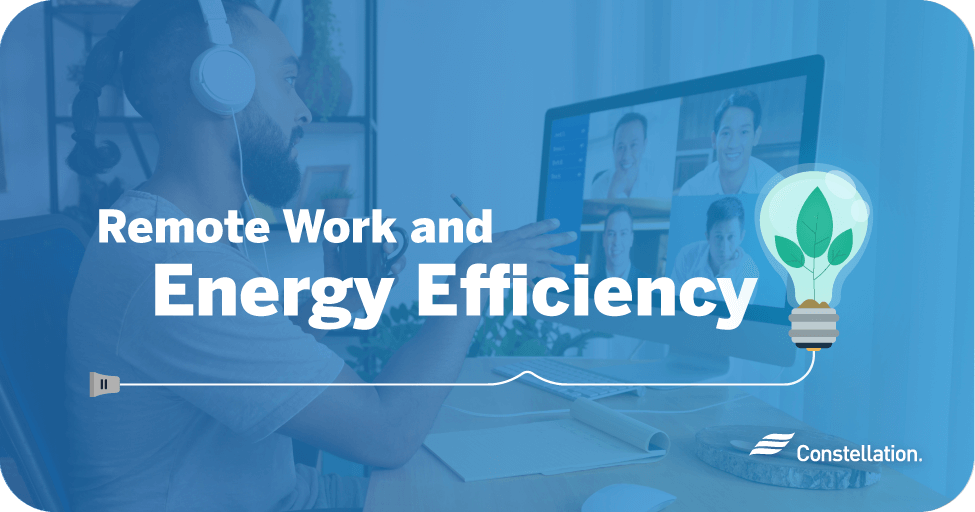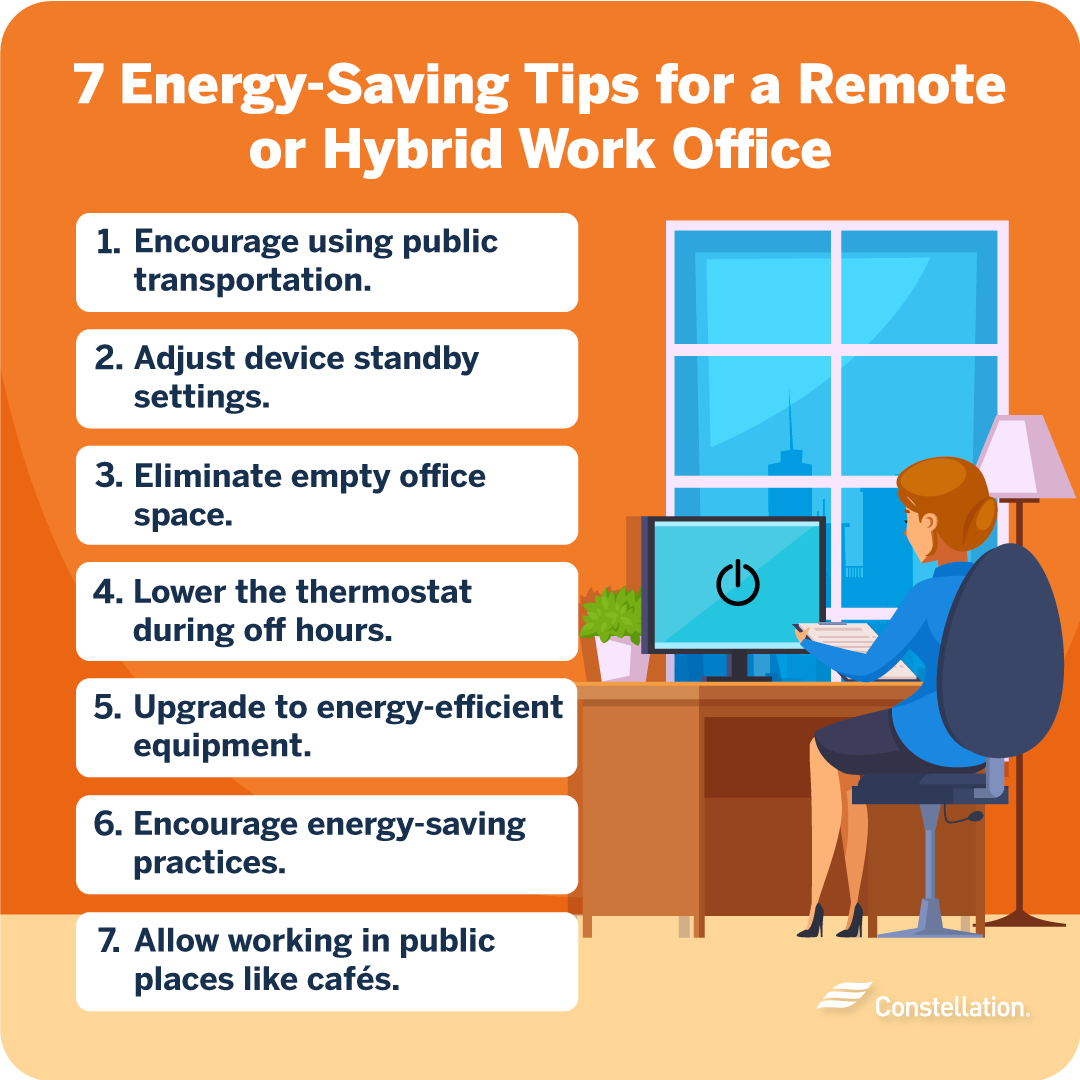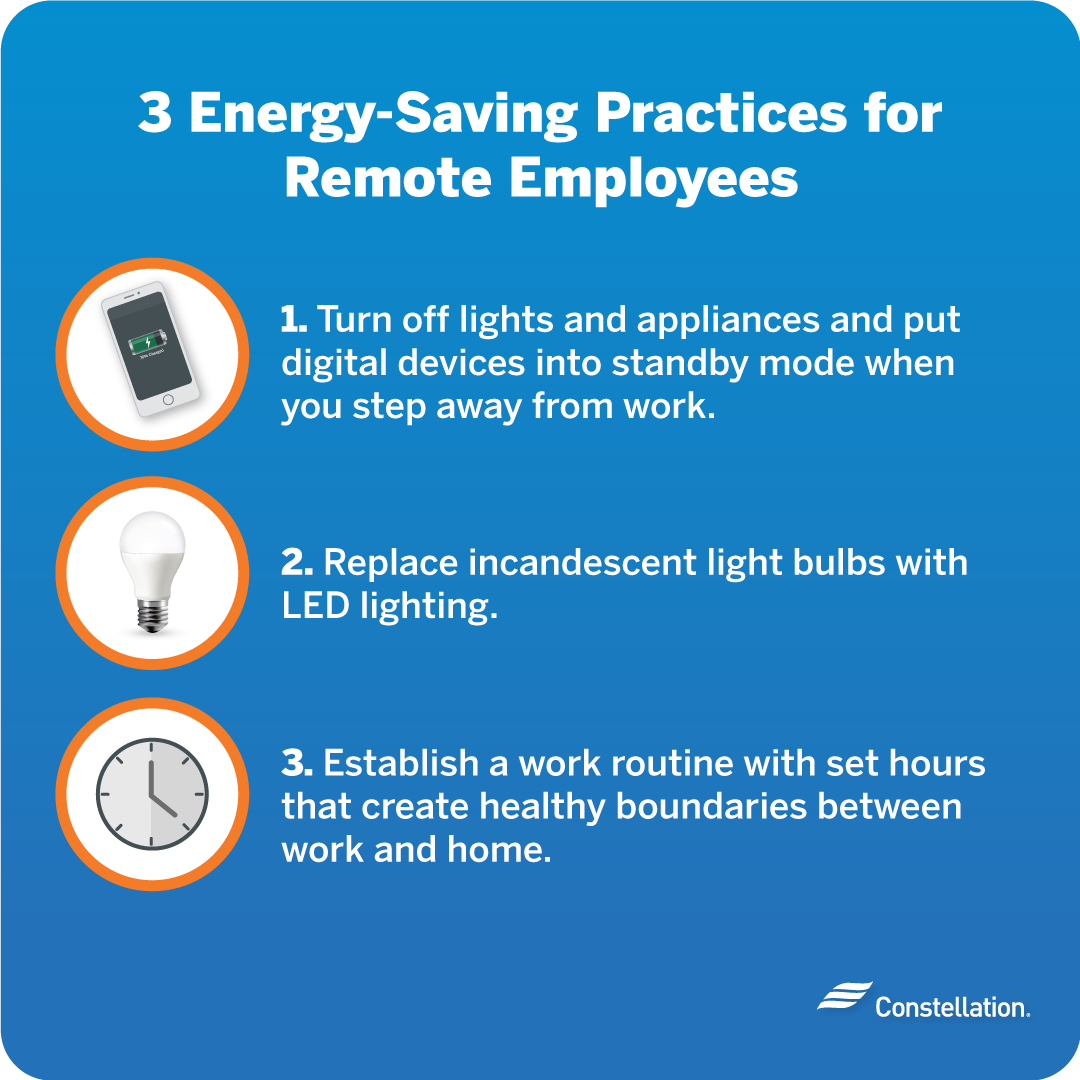
- Category:
Energy Efficiency -
Last updated:
May 10, 2024
Remote Work and Energy Efficiency
Is remote work sustainable? Can remote work and energy efficiency contribute to your bottom line and a cleaner environment? Working remotely has become more common and accepted in the aftermath of COVID-19.
Government statistics show that 27.5% of private-sector establishments allow remote or hybrid work all or part of the time, while 50% of respondents to MIT’s Remote Life Survey work remotely at least one day a week. Pew Research puts that number at 35%.
Whatever the true number, a significant part of the workforce now works from home all or part of the time. And when it comes to running your small business and managing remote workers, your bottom line will benefit from understanding remote work and energy efficiency.
Use these insights to best realize the potential benefits of remote work for your business.
Does working remotely make your business more energy efficient and sustainable?
If you have remote employees, the sustainability benefits for your business can be substantial. Remote staff have a carbon footprint up to 58% lower than those working onsite. Hybrid employees working from home a few days a week can lower your carbon footprint by 11-29%.
The actual lower remote work carbon footprint that your business can achieve will depend on several factors:
- Commute distance of your employees
- Frequency of remote vs onsite work
- Vehicle used for commuting
- Employee’s residential energy setup
- Workspace configuration, onsite and at home
7 Energy-saving tips for a remote or hybrid work office

Information and communications technology play a role in making remote work productive, but to get even more benefits from remote work, it helps to have a thoughtful plan and good coordination with your employees.
1. Encourage using public transportation
According to the US Energy Information Administration, transportation accounts for 37% of energy consumption. Encouraging employees to use public transportation for their commutes can dramatically lower their carbon footprint. For example, if an employee travels 20 miles to and from work, switching from a car to public transportation can lower their carbon footprint by 4,800 pounds of CO₂ every year. They can also save a significant amount in gas and car maintenance.
You can encourage the use of public transportation by offering commuter benefits or a public transportation expense reimbursement.
2. Adjust device standby settings
How technology is set up for employees working remotely will partly determine their carbon footprint. Set their equipment, such as monitors and computer towers, to go into standby or sleep mode if not used for 10-20 minutes. For longer periods of inactivity, computers should go into “hibernate” mode.
Automating a sleep mode can cut an ENERGY STAR®-labeled display’s power down to 0.5 watts or less. Note that a screen saver is not the same as a power saver, and may actually use more power and prevent a device from going into standby mode.
3. Eliminate empty office space
When employees are working from home, you can optimize energy efficiency by reducing the square footage of your facility. Rather than giving every worker their own space that sits empty many days of the week, consider seat sharing, or office hoteling.
Multiple workers can share a single space, each using it while the other is offsite. By eliminating unused space, you can save on rent, as well as the costs to heat, air-condition and power that workspace, cutting your carbon emissions by as much as 28%.
4. Lower the thermostat during off hours
Heating and cooling a workspace is a major part of a small business’s monthly energy usage. Making a few little changes in your habits can have a big impact on your bill.
Consider programming your thermostat to heat or cool only those portions of your facility that are occupied during business hours. Encourage your employees to do the same in their homes. If possible, employees can heat or cool only their office space while other residents in their home are away. This saves energy and may help reduce their personal energy bills.
At home and in your workplace, consider setting the thermostat a few degrees higher in summer and lower in winter. Even lowering your thermostat 7-10°F in the winter for 8 hours a day could save 10% a year on your HVAC energy consumption.
5. Upgrade to energy-efficient equipment
Invest in ENERGY STAR® computers, monitors, printers and other equipment. Just as you may own an ENERGY STAR® dishwasher or washing machine, you can also purchase ENERGY STAR®-labeled office equipment. These items can save as much as 75% of energy use.
When possible, have employees use a laptop computer. They use far less energy than a desktop and monitor; the average desktop consumes 194 kWh of electricity per year, while a laptop uses 75 kWh. Use the power management settings that further minimize energy use by adjusting display brightness, standby mode, keyboard illumination and others.
6. Encourage energy-saving practices

Sustainability when working from home and onsite efficiency are enhanced when you encourage workers to adopt energy-saving habits, such as the following:
- When you step away from work, turn off lights, fans and appliances. Plugging multiple devices into a power strip makes it easy to turn off potential power drains with one switch when taking a break or finishing the work day.
- Replace incandescent bulbs with LED lighting. LED bulbs are more energy efficient than incandescent bulbs. They also emit less heat, which will keep your workspace cooler in summer.
- Establish a work routine with set hours that create healthy boundaries between work and home. This helps reduce electricity consumption, because work devices won’t need to run 24 hours a day.
7. Allow working in public places like cafés
Some employees work better in a busy environment. When working from a coffee shop or co-work space, employees use the electricity from that facility. While it doesn’t reduce the remote work carbon footprint, it does remove the cost of electricity from your workplace or your employee’s home.
Working remotely in a public space can pose a cybersecurity threat, so ensure that workers are using a VPN for privacy and are in compliance with cybersecurity regulations.
Can you deduct home office from your small business taxes?
You and your employees can deduct certain home office expenses for your taxes. Consult an accountant to explore the nuances of the tax law and how answers to these basic questions may determine if your space could qualify for a home office tax deduction:
- Is your space an office? To qualify, you must be using your home “exclusively and regularly” as your place of business.
- Does the office need to be separate from the rest of the house? No. Any space that is “separately identifiable” as your workspace could qualify, and it does not need to be a separate room or include a wall or partition.
- Is your home a “principal place of business”? Your home must be where you conduct the majority of your productive work, as well as administrative and management activities.
You can measure your work space easily, but calculating the home office share of other expenses isn’t so straightforward. You can use the simplified method that allows you to simply take a deduction of $5 per square foot up to 300 feet, or $1,500. The alternative is to file Form 8829 and calculate actual costs you could deduct, such as:
- Mortgage interest
- Real estate taxes
- Utilities
- Home repairs and maintenance (with certain specifications)
- Homeowners’ insurance premiums
You multiply each expense by the percent of your home that’s being used as home office space. If you use 10% of your home for work and you pay $200 per month for gas and electricity, then you could deduct 10% of that or $20 per month.
Using a home office deduction calculator can help you calculate what is tax deductible. Some of the more popular home office deduction calculators include:
The future of remote and hybrid work
What is the future of working remotely? How will remote work and energy efficiency evolve? According to a study by Upwork, 22% of workers will be fully remote by 2025. A similar number is predicted in a recent McKinsey study on the future of remote work.
COVID-19 lock-downs accelerated an existing trend toward more flexible working arrangements. The McKinsey study noted above states that “the virus has broken through cultural and technological barriers that prevented remote work in the past.”
Remote work has the potential to improve productivity, expand your talent pool, cut costs and reduce your business’ carbon footprint. The other benefits of remote work will vary, depending on your industry, but with careful attention to details and a few minor changes in habit, your business can use remote work to become more energy efficient and profitable.




